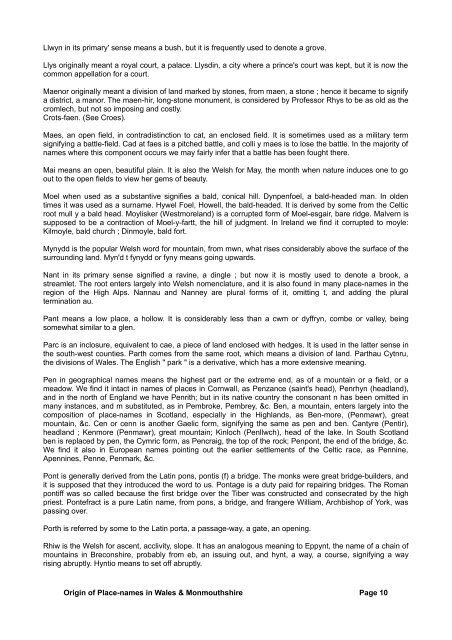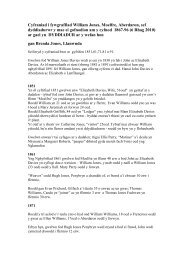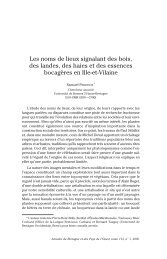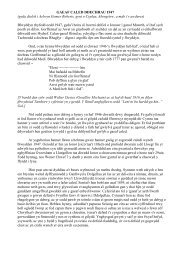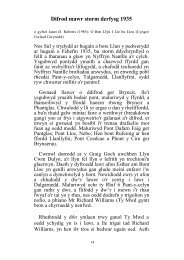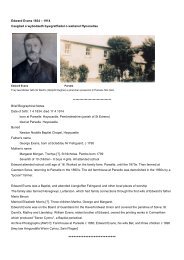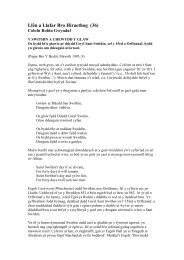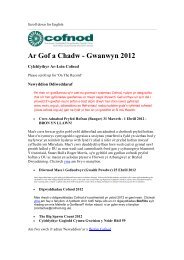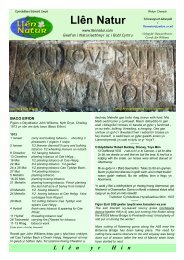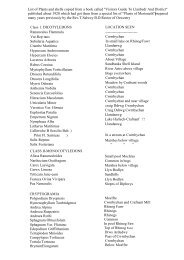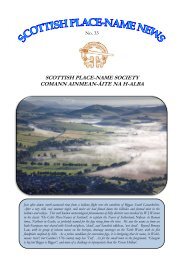Glyn implies a vale narrower but deeper than a dyffryn, through which a river flows. It generally precedes <strong>the</strong>name <strong>of</strong> a river that flows through a vale, as Glyn Ceiriog, Glyn Dyfrdwy, &c. From <strong>the</strong> same root we have<strong>the</strong> Gaelic " gleann " <strong>and</strong> <strong>the</strong> Anglo-Saxon "glen," both express<strong>in</strong>g a small valley.Gwydd signifies wood, from which we have gwyddel, which means a brake or bush. Tir gwyddtlawg, l<strong>and</strong>overrun with brambles. Gwyddel is also <strong>the</strong> Welsh for Irishman, <strong>and</strong> some view <strong>the</strong> few <strong>place</strong>-<strong>names</strong> thatconta<strong>in</strong> <strong>the</strong> word only as ethnological evidences <strong>of</strong> <strong>the</strong> temporary sojourn <strong>of</strong> <strong>the</strong> Gaels <strong>in</strong> Wales. Some,evidently, have <strong>the</strong> latter signification, but <strong>the</strong> majority <strong>of</strong> <strong>the</strong>m have no reference to Irishmen, asGwyddelwern, &c.Hafod is a compound <strong>of</strong> haf <strong>and</strong> bod, signify<strong>in</strong>g a summer house. The ancient farmers had <strong>the</strong>ir summerdairy-houses, <strong>and</strong> <strong>in</strong> that season <strong>the</strong>y resorted thi<strong>the</strong>r, as <strong>the</strong> farmers <strong>in</strong> <strong>the</strong> Swiss Alps do to <strong>the</strong>ir Sennes.The hafod consisted <strong>of</strong> a long, low room, with a hole at one end to emit <strong>the</strong> smoke from <strong>the</strong> fire which wasmade beneath. Its stools were stones, <strong>and</strong> beds were made <strong>of</strong> hay ranged along <strong>the</strong> sides.Llan is identified with nearly all <strong>the</strong> <strong>names</strong> <strong>of</strong> parish churches <strong>in</strong> Wales, from which an exceed<strong>in</strong>gly largenumber <strong>of</strong> <strong>place</strong>s take <strong>the</strong>ir <strong>names</strong>. It has been said that " Engl<strong>and</strong> is pre-em<strong>in</strong>ently <strong>the</strong> l<strong>and</strong> <strong>of</strong> hedges <strong>and</strong><strong>in</strong>closures." The term<strong>in</strong>ations, ton, ham, worth, stoke, fold, garth, park, burgh, bury, brough, burrow, almost<strong>in</strong>variably convey <strong>the</strong> notion <strong>of</strong> <strong>in</strong>closure <strong>and</strong> protection. The Welsh prefix Llan, which signifies a sacred<strong>in</strong>closure, probably suggested <strong>the</strong> idea to <strong>the</strong> Saxon colonists. We f<strong>in</strong>d <strong>the</strong> word <strong>in</strong> perllan, orchard; gw<strong>in</strong>llan,v<strong>in</strong>eyard; corlan, sheep-yard, <strong>in</strong> Welsh <strong>place</strong>- <strong>names</strong> it generally means a church, probably <strong>in</strong>clud<strong>in</strong>g <strong>the</strong>church-yard. Mynedfrllan means'* go<strong>in</strong>g to church." The British sa<strong>in</strong>ts, hav<strong>in</strong>g been deprived <strong>of</strong> <strong>the</strong>irpossessions by <strong>the</strong> powerful <strong>and</strong> ever-<strong>in</strong>creas<strong>in</strong>g foreigners <strong>and</strong> <strong>in</strong>vaders, retired to <strong>the</strong> most solitary <strong>place</strong>s<strong>in</strong> <strong>the</strong> country to live a wholly religious life, <strong>and</strong> founded churches which will bear <strong>the</strong>ir <strong>names</strong> as long ashagiology will rema<strong>in</strong> a part <strong>of</strong> Welsh history. Judg<strong>in</strong>g from <strong>the</strong> number <strong>of</strong> churches dedicated to <strong>the</strong> sa<strong>in</strong>ts, itappears that <strong>the</strong> most popular among <strong>the</strong>m were St. Mary, St. Michael, <strong>and</strong> St. David, <strong>the</strong> patron sa<strong>in</strong>t <strong>of</strong>Wales. It is needless to say that <strong>the</strong> first two never founded churches, although we f<strong>in</strong>d that 26 churches <strong>in</strong><strong>the</strong> see <strong>of</strong> Bangor; 27 <strong>in</strong> <strong>the</strong> see <strong>of</strong> St. Asaph; 59 <strong>in</strong> <strong>the</strong> see <strong>of</strong> St. David's; <strong>and</strong> a few <strong>in</strong> <strong>the</strong> see <strong>of</strong> Ll<strong>and</strong>aff; <strong>in</strong>all about 150 churches <strong>and</strong> chapels have been dedicated to St. Mary, <strong>and</strong> to St. Michael: 48 <strong>in</strong> <strong>the</strong> see <strong>of</strong> St.David's; 8 <strong>in</strong> <strong>the</strong> see <strong>of</strong> St. Asaph; 16 <strong>in</strong> <strong>the</strong> see <strong>of</strong> Bangor; 20 <strong>in</strong> <strong>the</strong> see <strong>of</strong> Ll<strong>and</strong>aff; <strong>and</strong> a few <strong>in</strong> <strong>the</strong> see <strong>of</strong>Hereford, mak<strong>in</strong>g a total <strong>of</strong> nearly 100. Next comes St. David. We f<strong>in</strong>d that 42 sacred edifices bear his name<strong>in</strong> <strong>the</strong> see <strong>of</strong> St. David's; 8 <strong>in</strong> <strong>the</strong> see <strong>of</strong> Ll<strong>and</strong>aff; <strong>and</strong> a few <strong>in</strong> <strong>the</strong> see <strong>of</strong> Hereford. Many churches were alsonamed from <strong>the</strong>ir contiguity to water, as well as to -o<strong>the</strong>r objects: Llanwrtyd (Llan- wrth-y-rhyd), <strong>the</strong> church by<strong>the</strong> ford ; Ll<strong>and</strong>daff <strong>the</strong> church on <strong>the</strong> Taff, &c. The llan, a public house, <strong>and</strong> a few cottages, formed <strong>the</strong>nucleus <strong>of</strong> <strong>the</strong> majority <strong>of</strong> our rural villages <strong>and</strong> parishes, <strong>and</strong> when <strong>the</strong> village or parish became worthy <strong>of</strong> anappellation, <strong>the</strong> name <strong>of</strong> <strong>the</strong> llan was almost <strong>in</strong>variably applied to <strong>the</strong>m. The word sant, sa<strong>in</strong>t, never becamea popular term <strong>in</strong> Wales. We have simply <strong>the</strong> llan <strong>and</strong> <strong>the</strong> unadorned name <strong>of</strong> <strong>the</strong> sa<strong>in</strong>t to whom it wasdedicated, not Llansantddewi, St. David's church, but Ll<strong>and</strong>dewi, David's church.When several churches are dedicated to <strong>the</strong> same sa<strong>in</strong>t some differential words are added, <strong>and</strong> so we havethose long <strong>names</strong> which arouse <strong>the</strong> curiosity <strong>of</strong> our English friends, <strong>and</strong> <strong>of</strong>ten supply a healthy exercise to<strong>the</strong>ir risible faculties, such as Llanfair-Mathafarneithafy &c.For <strong>the</strong> sake <strong>of</strong> euphony <strong>and</strong> brevity we have, <strong>in</strong> many <strong>of</strong> our English equivalents, omitted <strong>the</strong> word llan ~<strong>and</strong> have given <strong>the</strong> <strong>names</strong> <strong>of</strong> <strong>the</strong> sa<strong>in</strong>ts only, except when <strong>the</strong>y are translatable. When differential words areadded to <strong>the</strong> hagiological <strong>names</strong>, as Penybryn, Helygen, &c, we have thought it advisable to omit <strong>the</strong>ecclesiastical term, <strong>and</strong> give <strong>the</strong> mundane portion <strong>of</strong> <strong>the</strong> name only as an English quasi-equivalent. For<strong>in</strong>stance, Ll<strong>and</strong>ewi-Aberarth, omitt<strong>in</strong>g St. David's, <strong>and</strong> render Aberarth <strong>in</strong>to an <strong>in</strong>telligible English name. Wef<strong>in</strong>d <strong>the</strong> word llan <strong>in</strong> many <strong>place</strong>-<strong>names</strong> <strong>in</strong> Engl<strong>and</strong>, <strong>in</strong> <strong>the</strong> Cymric part <strong>of</strong> Scotl<strong>and</strong>, as Lanark, Lanrick, &c,<strong>and</strong> <strong>in</strong> Brittany, as Langeac, Lannion, Lanoe, &c. It is now superseded by <strong>the</strong> word egluys, church, <strong>in</strong> mostparts <strong>of</strong> <strong>the</strong> Pr<strong>in</strong>cipality.Llech, a flat stone, a flag, refers probably to <strong>the</strong> Druidical circle stones. Notice should be made <strong>of</strong> <strong>the</strong>difference between Cromlech <strong>and</strong> Cistfaen. The former was a sepulchral monument <strong>and</strong> always aboveground, <strong>and</strong> <strong>the</strong> latter was <strong>the</strong> c<strong>of</strong>f<strong>in</strong>, concealed ei<strong>the</strong>r by a tumulus <strong>of</strong> earth or stones. The cromlechgenerally had a cistfaen under it. The English league is probably derived from this word, a "league*' was ameasure <strong>of</strong> distance marked by a stone st<strong>and</strong><strong>in</strong>g on end.Llwch is <strong>the</strong> ancient Welsh for an <strong>in</strong>let <strong>of</strong> water, a lake. It corresponds to <strong>the</strong> Scottish lock, <strong>the</strong> Irish lough,<strong>and</strong> <strong>the</strong> English lake. Loch Leven - smooth lake.Orig<strong>in</strong> <strong>of</strong> Place-<strong>names</strong> <strong>in</strong> Wales & Monmouthshire Page 9
Llwyn <strong>in</strong> its primary' sense means a bush, but it is frequently used to denote a grove.Llys <strong>orig<strong>in</strong></strong>ally meant a royal court, a palace. Llysd<strong>in</strong>, a city where a pr<strong>in</strong>ce's court was kept, but it is now <strong>the</strong>common appellation for a court.Maenor <strong>orig<strong>in</strong></strong>ally meant a division <strong>of</strong> l<strong>and</strong> marked by stones, from maen, a stone ; hence it became to signifya district, a manor. The maen-hir, long-stone monument, is considered by Pr<strong>of</strong>essor Rhys to be as old as <strong>the</strong>cromlech, but not so impos<strong>in</strong>g <strong>and</strong> costly.Crots-faen. (See Croes).Maes, an open field, <strong>in</strong> contradist<strong>in</strong>ction to cat, an enclosed field. It is sometimes used as a military termsignify<strong>in</strong>g a battle-field. Cad at faes is a pitched battle, <strong>and</strong> colli y maes is to lose <strong>the</strong> battle. In <strong>the</strong> majority <strong>of</strong><strong>names</strong> where this component occurs we may fairly <strong>in</strong>fer that a battle has been fought <strong>the</strong>re.Mai means an open, beautiful pla<strong>in</strong>. It is also <strong>the</strong> Welsh for May, <strong>the</strong> month when nature <strong>in</strong>duces one to goout to <strong>the</strong> open fields to view her gems <strong>of</strong> beauty.Moel when used as a substantive signifies a bald, conical hill. Dynpenfoel, a bald-headed man. In oldentimes it was used as a surname. Hywel Foel, Howell, <strong>the</strong> bald-headed. It is derived by some from <strong>the</strong> Celticroot mull y a bald head. Moylisker (Westmorel<strong>and</strong>) is a corrupted form <strong>of</strong> Moel-esgair, bare ridge. Malvern issupposed to be a contraction <strong>of</strong> Moel-y-fartt, <strong>the</strong> hill <strong>of</strong> judgment. In Irel<strong>and</strong> we f<strong>in</strong>d it corrupted to moyle:Kilmoyle, bald church ; D<strong>in</strong>moyle, bald fort.Mynydd is <strong>the</strong> popular Welsh word for mounta<strong>in</strong>, from mwn, what rises considerably above <strong>the</strong> surface <strong>of</strong> <strong>the</strong>surround<strong>in</strong>g l<strong>and</strong>. Myn'd t fynydd or fyny means go<strong>in</strong>g upwards.Nant <strong>in</strong> its primary sense signified a rav<strong>in</strong>e, a d<strong>in</strong>gle ; but now it is mostly used to denote a brook, astreamlet. The root enters largely <strong>in</strong>to Welsh nomenclature, <strong>and</strong> it is also found <strong>in</strong> many <strong>place</strong>-<strong>names</strong> <strong>in</strong> <strong>the</strong>region <strong>of</strong> <strong>the</strong> High Alps. Nannau <strong>and</strong> Nanney are plural forms <strong>of</strong> it, omitt<strong>in</strong>g t, <strong>and</strong> add<strong>in</strong>g <strong>the</strong> pluralterm<strong>in</strong>ation au.Pant means a low <strong>place</strong>, a hollow. It is considerably less than a cwm or dyffryn, combe or valley, be<strong>in</strong>gsomewhat similar to a glen.Parc is an <strong>in</strong>closure, equivalent to cae, a piece <strong>of</strong> l<strong>and</strong> enclosed with hedges. It is used <strong>in</strong> <strong>the</strong> latter sense <strong>in</strong><strong>the</strong> south-west counties. Parth comes from <strong>the</strong> same root, which means a division <strong>of</strong> l<strong>and</strong>. Parthau Cytnru,<strong>the</strong> divisions <strong>of</strong> Wales. The English " park " is a derivative, which has a more extensive mean<strong>in</strong>g.Pen <strong>in</strong> geographical <strong>names</strong> means <strong>the</strong> highest part or <strong>the</strong> extreme end, as <strong>of</strong> a mounta<strong>in</strong> or a field, or ameadow. We f<strong>in</strong>d it <strong>in</strong>tact <strong>in</strong> <strong>names</strong> <strong>of</strong> <strong>place</strong>s <strong>in</strong> Cornwall, as Penzance (sa<strong>in</strong>t's head), Penrhyn (headl<strong>and</strong>),<strong>and</strong> <strong>in</strong> <strong>the</strong> north <strong>of</strong> Engl<strong>and</strong> we have Penrith; but <strong>in</strong> its native country <strong>the</strong> consonant n has been omitted <strong>in</strong>many <strong>in</strong>stances, <strong>and</strong> m substituted, as <strong>in</strong> Pembroke, Pembrey, &c. Ben, a mounta<strong>in</strong>, enters largely <strong>in</strong>to <strong>the</strong>composition <strong>of</strong> <strong>place</strong>-<strong>names</strong> <strong>in</strong> Scotl<strong>and</strong>, especially <strong>in</strong> <strong>the</strong> Highl<strong>and</strong>s, as Ben-more, (Penmawr), greatmounta<strong>in</strong>, &c. Cen or cenn is ano<strong>the</strong>r Gaelic form, signify<strong>in</strong>g <strong>the</strong> same as pen <strong>and</strong> ben. Cantyre (Pentir),headl<strong>and</strong> ; Kenmore (Penmawr), great mounta<strong>in</strong>; K<strong>in</strong>loch (Penllwch), head <strong>of</strong> <strong>the</strong> lake. In South Scotl<strong>and</strong>ben is re<strong>place</strong>d by pen, <strong>the</strong> Cymric form, as Pencraig, <strong>the</strong> top <strong>of</strong> <strong>the</strong> rock; Penpont, <strong>the</strong> end <strong>of</strong> <strong>the</strong> bridge, &c.We f<strong>in</strong>d it also <strong>in</strong> European <strong>names</strong> po<strong>in</strong>t<strong>in</strong>g out <strong>the</strong> earlier settlements <strong>of</strong> <strong>the</strong> Celtic race, as Penn<strong>in</strong>e,Apenn<strong>in</strong>es, Penne, Penmark, &c.Pont is generally derived from <strong>the</strong> Lat<strong>in</strong> pons, pontis (f) a bridge. The monks were great bridge-builders, <strong>and</strong>it is supposed that <strong>the</strong>y <strong>in</strong>troduced <strong>the</strong> word to us. Pontage is a duty paid for repair<strong>in</strong>g bridges. The Romanpontiff was so called because <strong>the</strong> first bridge over <strong>the</strong> Tiber was constructed <strong>and</strong> consecrated by <strong>the</strong> highpriest. Pontefract is a pure Lat<strong>in</strong> name, from pons, a bridge, <strong>and</strong> frangere William, Archbishop <strong>of</strong> York, waspass<strong>in</strong>g over.Porth is referred by some to <strong>the</strong> Lat<strong>in</strong> porta, a passage-way, a gate, an open<strong>in</strong>g.Rhiw is <strong>the</strong> Welsh for ascent, acclivity, slope. It has an analogous mean<strong>in</strong>g to Eppynt, <strong>the</strong> name <strong>of</strong> a cha<strong>in</strong> <strong>of</strong>mounta<strong>in</strong>s <strong>in</strong> Breconshire, probably from eb, an issu<strong>in</strong>g out, <strong>and</strong> hynt, a way, a course, signify<strong>in</strong>g a wayris<strong>in</strong>g abruptly. Hyntio means to set <strong>of</strong>f abruptly.Orig<strong>in</strong> <strong>of</strong> Place-<strong>names</strong> <strong>in</strong> Wales & Monmouthshire Page 10
- Page 1 and 2: HANDBOOK OF THE ORIGIN OF PLACE-NAM
- Page 3 and 4: § § § § §The Author begs to st
- Page 5 and 6: pitiful cries of the railway offici
- Page 7 and 8: Bishop Percy says that "in England,
- Page 9 and 10: The city of Chester is still popula
- Page 11: There's Cumwhitton, Cumwhinton, Cum
- Page 15 and 16: PLACE-NAMES IN WALES.Wales. — The
- Page 17 and 18: Church are generally dedicated to e
- Page 19 and 20: think he was a contemporary of St.
- Page 21 and 22: Rhosbeirio. — Rhos, a moor, a dry
- Page 23 and 24: of Brecknock," states that this vic
- Page 25 and 26: Cam cnwir ef Cwmdu,Cwm gwyn yw & n
- Page 27 and 28: Penderyn. — A corruption probably
- Page 29 and 30: Ardudwy. — Ar, upon or above; tud
- Page 31 and 32: to mark its pre-eminence over the o
- Page 33 and 34: Some think that eirw is a corruptio
- Page 35 and 36: present form — Caerfyrddin.Abergw
- Page 37 and 38: place of refuge; hence the name. En
- Page 39 and 40: Llansawyl. — The church was dedic
- Page 41 and 42: eject. The village took its name fr
- Page 43 and 44: house, and attempted to kill an inf
- Page 45 and 46: Gwydir. — Prima facie one may tak
- Page 47 and 48: Nefyn. — The church was probably
- Page 49 and 50: DENBIGHSHIRE.Anglicized form of Din
- Page 51 and 52: Llangollen. — From Collen, a sain
- Page 53 and 54: hands into their pockets to pay a c
- Page 55 and 56: Cefn. — The name signifies a ridg
- Page 57 and 58: Maesgarmon. — Named in honour of
- Page 59 and 60: Abertridwr. — Tridwr, three water
- Page 61 and 62: it is said, was originally built by
- Page 63 and 64:
Cwmllynfell. — Cwm, a narrow vale
- Page 65 and 66:
Gwarycaeau. — Gwdr, the nape of t
- Page 67 and 68:
means a cultivated region, a vale,
- Page 69 and 70:
Penrhiwfer.- Pen, head, top; rhiw,
- Page 71 and 72:
Port Talbot. — So called in 1835
- Page 73 and 74:
Trealaw. — This appellation was g
- Page 75 and 76:
Aberdyfi. — So called from its si
- Page 77 and 78:
Llanddwywe. — From Dwywau, a desc
- Page 79 and 80:
Crickhowell and some in the directi
- Page 81 and 82:
Griffithstown. — This village was
- Page 83 and 84:
and gwy, water. Treiddiod troth tna
- Page 85 and 86:
derive Tintern from din, fortified
- Page 87 and 88:
Caersws. — It appears that the Ro
- Page 89 and 90:
English name — Ervylton.Llanymech
- Page 91 and 92:
Angle. — Probably from the angle-
- Page 93 and 94:
Gellyswick. — Another hybrid. Gel
- Page 95 and 96:
that the two rivers in their flowin
- Page 97 and 98:
ecame the bishop of the see, and wa
- Page 99 and 100:
earth formerly stood on a summit on
- Page 101 and 102:
Pilleth. — A corruption of pwll,
- Page 103 and 104:
Howells, Rev. J., Mountain AshHowel
- Page 105 and 106:
Williams, D., PenywernWilliams, Rev


